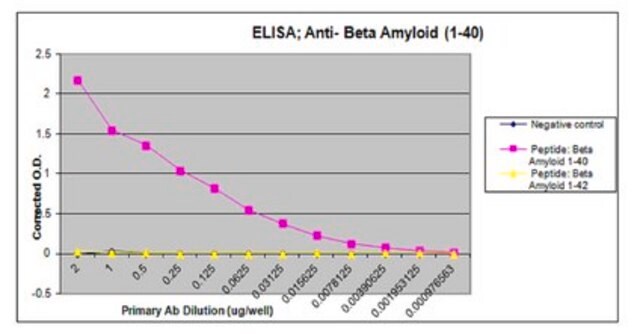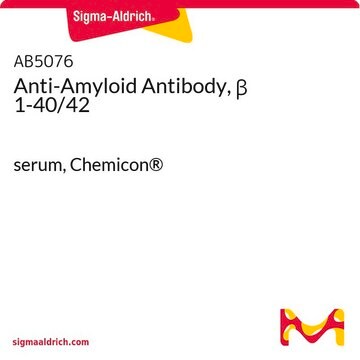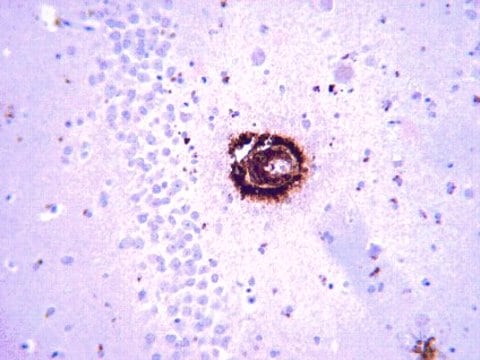MABN12
Anti-Amyloid β42 Antibody, clone G2-11
clone G2-11, from mouse
別名:
Alzheimer disease, Alzheimer disease amyloid protein, Cerebral vascular amyloid peptide, Protease nexin-II, amyloid beta (A4) precursor protein, amyloid beta A4 protein, amyloid beta precursor protein, beta-amyloid peptide, human mRNA for amyloid A4 prec
ログイン組織・契約価格を表示する
すべての画像(1)
About This Item
UNSPSCコード:
12352203
eCl@ss:
32160702
NACRES:
NA.41
おすすめの製品
詳細
The cerebral and vascular plaques associated with Alzheimer′s disease (AD) are mainly composed of amyloid beta peptides (Aβ). Aβ is derived from cleavage of the amyloid precursor protein (APP) and varies in length from 39 to 43 amino acids. Aβ [1-40], Aβ [1-42], and Aβ [1-43] peptides result from cleavage of APP after residues 40, 42, and 43, respectively. The cleavage takes place by gamma-secretase during the last APP processing step. Aβ [1-40], [1-42] and [1-43] peptides are major constituents of the plaques and tangles that occur in AD. Aβ antibodies and peptides have been developed as tools for elucidating the biology of AD.
特異性
This antibody recognizes human Amyloid β42 at the C-terminus.
免疫原
Epitope: C-terminus
KLH-conjugated linear peptide corresponding to the C-terminus of Amyloid β42.
アプリケーション
Research Category
ニューロサイエンス
ニューロサイエンス
Research Sub Category
神経変性疾患
神経変性疾患
Anti-Amyloid β42 Antibody, clone G2-11 detects level of Amyloid β42 & has been published & validated for use in WB, WB, ELISA, IH.
ELISA: A representative lot of MABN12 antibody was used in a titer ELISA. Specificity of Amyloid beta peptide detection is displayed below.
品質
Evaluated by Western Blot on human Alzheimer diseased brain tissue lysate.
Western Blot Analysis: 1 µg/ml of this antibody detected Amyloid β42 in 10 µg of human Alzheimer diseased brain tissue lysate.
Western Blot Analysis: 1 µg/ml of this antibody detected Amyloid β42 in 10 µg of human Alzheimer diseased brain tissue lysate.
ターゲットの説明
4 kDa
物理的形状
Protein G Purified
Format: Purified
Purified mouse monoclonal IgG1κ in buffer containing 0.1 M Tris-Glycine (pH 7.4, 150 mM NaCl) with 0.05% sodium azide.
保管および安定性
Stable for 1 year at 2-8°C from date of receipt.
アナリシスノート
Control
Human Alzheimer diseased brain tissue lysate
Human Alzheimer diseased brain tissue lysate
その他情報
Concentration: Please refer to the Certificate of Analysis for the lot-specific concentration.
免責事項
Unless otherwise stated in our catalog or other company documentation accompanying the product(s), our products are intended for research use only and are not to be used for any other purpose, which includes but is not limited to, unauthorized commercial uses, in vitro diagnostic uses, ex vivo or in vivo therapeutic uses or any type of consumption or application to humans or animals.
保管分類コード
12 - Non Combustible Liquids
WGK
WGK 1
引火点(°F)
Not applicable
引火点(℃)
Not applicable
適用法令
試験研究用途を考慮した関連法令を主に挙げております。化学物質以外については、一部の情報のみ提供しています。 製品を安全かつ合法的に使用することは、使用者の義務です。最新情報により修正される場合があります。WEBの反映には時間を要することがあるため、適宜SDSをご参照ください。
Jan Code
MABN12:
試験成績書(COA)
製品のロット番号・バッチ番号を入力して、試験成績書(COA) を検索できます。ロット番号・バッチ番号は、製品ラベルに「Lot」または「Batch」に続いて記載されています。
Adriana Sofranko et al.
Particle and fibre toxicology, 19(1), 23-23 (2022-03-27)
There is an increasing concern about the neurotoxicity of engineered nanomaterials (NMs). To investigate the effects of subchronic oral exposures to SiO2 and CeO2 NMs on Alzheimer's disease (AD)-like pathology, 5xFAD transgenic mice and their C57BL/6J littermates were fed ad
Sophia Schedin-Weiss et al.
Alzheimer's research & therapy, 9(1), 57-57 (2017-08-03)
Increased levels of the pathogenic amyloid β-peptide (Aβ), released from its precursor by the transmembrane protease γ-secretase, are found in Alzheimer disease (AD) brains. Interestingly, monoamine oxidase B (MAO-B) activity is also increased in AD brain, but its role in
Tina Wahle et al.
Neurochemistry international, 138, 104755-104755 (2020-05-19)
Increasing evidence from toxicological and epidemiological studies indicates that the brain is an important target for ambient (ultrafine) particles. Disturbance of redox-homeostasis and inflammation in the brain are proposed as possible mechanisms that can contribute to neurotoxic and neurodegenerative effects.
Lisa Dolfe et al.
Journal of Alzheimer's disease reports, 2(1), 27-39 (2018-11-28)
Alzheimer's disease (AD) is the most common form of dementia and there is no successful treatment available. Evidence suggests that fibril formation of the amyloid β-peptide (Aβ) is a major underlying cause of AD, and treatment strategies that reduce the
Weigang Cui et al.
Molecular medicine reports, 22(2), 739-750 (2020-05-30)
Cognitive impairment and neuro‑inflammatory responses are the distinctive characteristics of Alzheimer's disease (AD). Tormentic acid (TA) is one of the major active components of Potentilla chinensis and has been demonstrated to have anti‑inflammatory properties. However, the potential effects of TA on
ライフサイエンス、有機合成、材料科学、クロマトグラフィー、分析など、あらゆる分野の研究に経験のあるメンバーがおります。.
製品に関するお問い合わせはこちら(テクニカルサービス)








